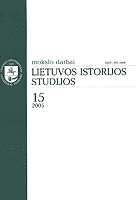SOCIALINIŲ SANTYKIŲ BIZANTIŠKOSIOS CIVILIZACIJOS ŠALYSE VII-XIV AMŽIUJE TIPOLOGIJOS METMENYS
AN OUTLINE OF TYPOLOGY OF SOCIAL RELATIONS IN THE COUNTRIES OF BYZANTINE CIVILIZATION IN THE VII–XIV CENTURIES
Author(s): Nerijus BabinskasSubject(s): History
Published by: Vilniaus Universiteto Leidykla
Summary/Abstract: The main concepts which the author operates in his attempt to describe typologically a type of social relations in the area of Byzantine civilization in the Middle ages are: an Asiatic mode of production, a slave mode of production, feudalism and so called semi-feudalism. According to E. Gudavièius there were two ways of historical development of the humankind: the main one (exstensive) and the exceptional one (intensive). Absolute majority of civilisations developed towards the pattern of the main way. The first exception was the Ancient Greece in the archaic period (VIII–VI century BC). The most important thing was that the idea of private property was born during that period. The Rome also continued to develop in this direction but at the end of antiquity it reached the deadlock (during the barbarian invasions in IV–V century AD). Nevertheless the Roman ruins were “radioactive”: Germanic tribes became acquainted with the idea of the private property. Because of that the allodial property of land and a holding of individual producer was born. So the exceptional way of production had reborn and had acquired a new quality. As a contrast the productive cell of civilisations of the main way remained community. There have been no private property. Such a kind of societies were ruled by a despot or a board of priests. These are the main features of Asiatic mode of production. According to E. Gudavièius, the type of social structure characteristic to Byzantine Empire and Russia could be described as semi-feudal. There were latifundia in the Byzantium but the owners of these latifundia exploited not the individual holdings of peasants but the whole communities. So the social structure of Byzantine Empire remained transmixed between the slave and the feudal mode of production.[...] .
Journal: Lietuvos istorijos studijos
- Issue Year: 2005
- Issue No: 16
- Page Range: 9-18
- Page Count: 10
- Language: Lithuanian

